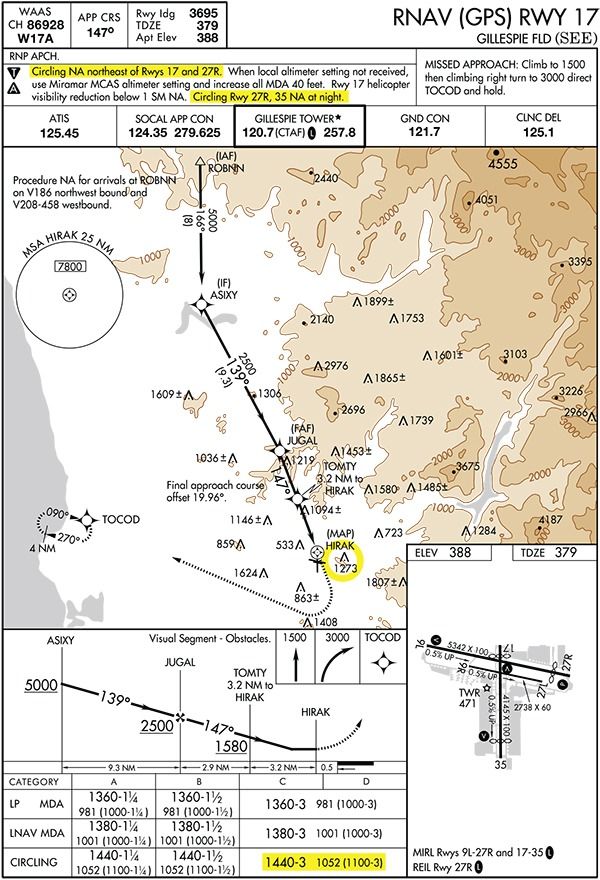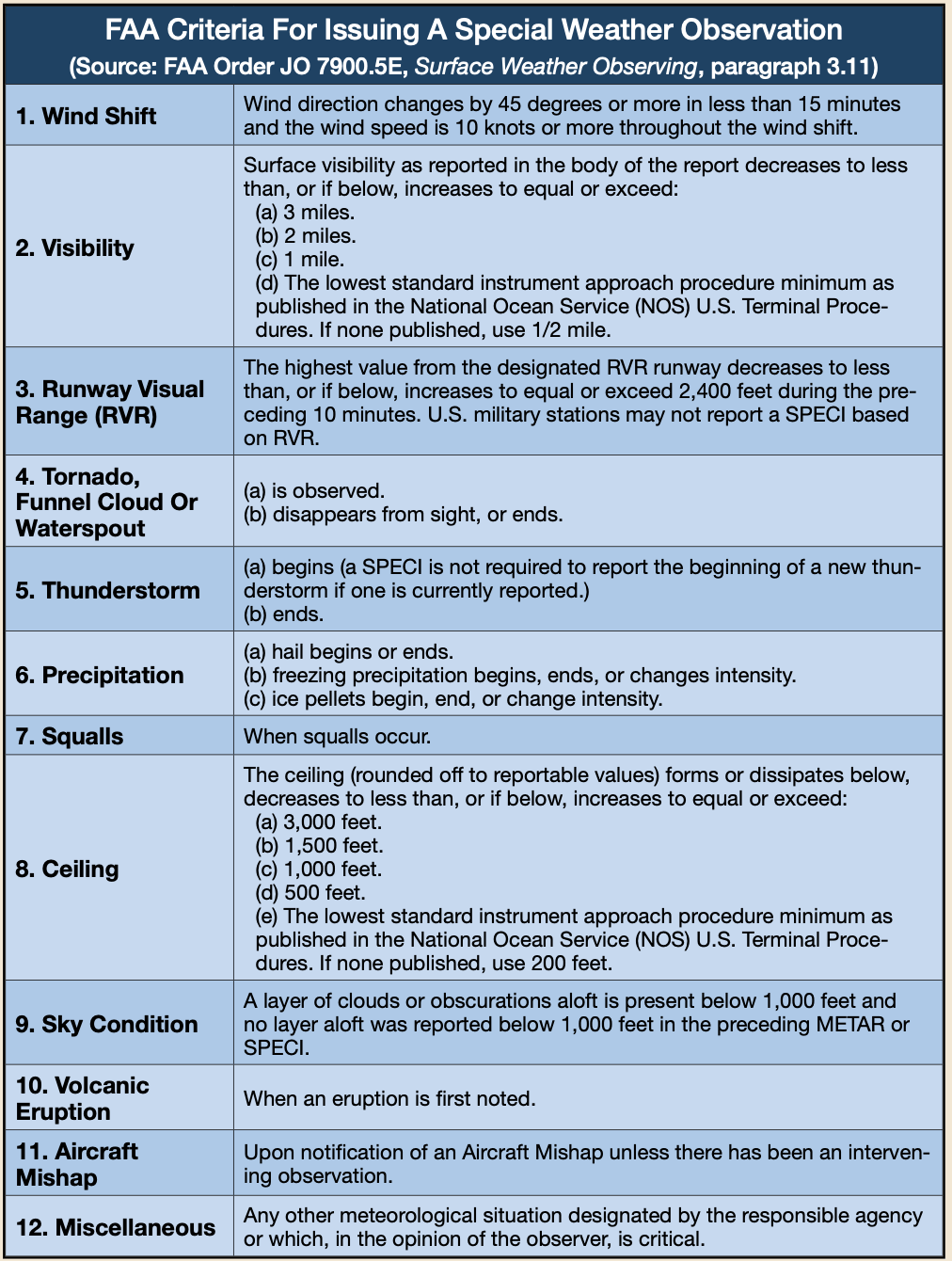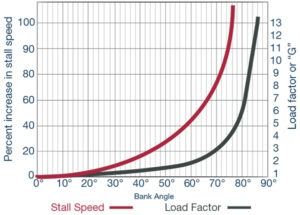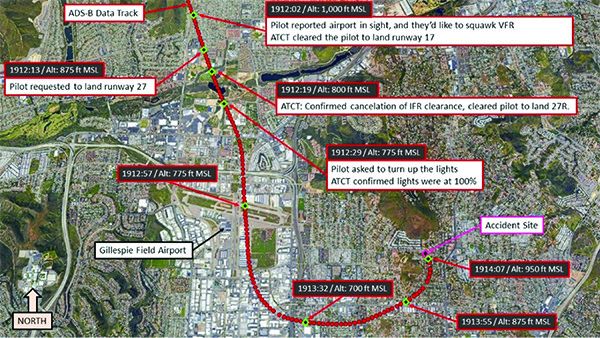In late December 2021, I was giving upset recovery training to a student. We were done with our work in the practice area and were returning to base at Montgomery-Gibbs Executive Airport in San Diego. Weather included unlimited visibility and scattered clouds. We picked up the ATIS and were heading toward the airport. A few minutes later, seated in the rear seat, I heard my student come over the intercom to confess that he didn’t really know where we were or how to get back home. This student has hundreds of hours of flying experience in the San Diego area, and I regard him as a serious and highly competent pilot. Still, the scattered clouds were obscuring some of the landmarks we subconsciously use to orient ourselves, and this made pilotage difficult.
A few days later, at the nearby Gillespie Field Airport (KSEE), a Learjet 35 crashed as it attempted to land. The Lear’s crew cancelled IFR on short final, and was flying a VFR pattern to a landing on another runway when the airplane collided with terrain. All four occupants aboard this aeromedical flight—two flightcrew members and two flight nurses—died in the accident. Of course, NTSB and FAA investigations have just begun, and we still do not know the specific cause of this crash. Still, the facts we know reveal several factors that may have contributed to the accident. Considering them can help us avoid similar accidents in the future.
WHAT WE KNOW
The accident airplane was a Gates Learjet 35A flying with a Part 135 air ambulance operator based at Gillespie Field. Its crew was returning to base at 2115 local time that evening in night marginal VFR conditions. Weather reported 20 minutes prior to the crash included visibility of three miles and a broken ceiling at 2000 feet under a 3000-foot overcast. Although not captured by the Metar at Gillespie, other airports in the vicinity were reporting scattered clouds below the overcast.
Gillespie Field is in El Cajon, a suburb of San Diego. The Spanish term “El Cajon” means “the box,” and accurately represents the geography of the area: a valley, boxed in by hilly terrain. Gillespie Field has three runways, and this Part 135 operation’s specifications required the crew to use the longest runway, 27R/9L. Prevailing winds are usually from the west, favoring Runway 27R.
Because of the terrain around Gillespie Field, all instrument approaches for landing on Runway 27R require a circle-to-land maneuver. This is thanks to Rattlesnake Mountain, a 1273-foot-high hill positioned slightly north of the final to 27R. Circling minimums (there is no straight-in procedure to Runway 27R) for approach category C aircraft vary from 1940 feet and three miles on the LOC-D approach to 1440 feet and three on the RNAV (GPS) Runway 17 approach.
It was standard practice for the operator to cancel IFR as they approached the airport, and fly a visual pattern (or a straight-in, as the case may be) for landing on Runway 27R. That night, the crew flew the RNAV (GPS) Runway 17 approach, and cancelled IFR on final with the intention of flying a visual pattern to land on Runway 27R. The ADS-B data, reproduced in the NTSB graphic at the bottom of the opposite page, show the jet commencing the pattern at an altitude of 900 feet msl—approximately 500 feet above the field elevation—and descending to 725 feet (338 feet agl) during the maneuver. The crew asked the tower to increase the intensity of the runway lights, to which tower responds that the runway lights were already at full intensity. As the jet turns from base to final in the face of Rattlesnake Mountain, the aircraft is seen departing controlled flight. Engine thrust is heard increasing. The pilot is heard yelling expletives on the radio and ground impact ensues.

The RNAV (GPS) RWY 17 approach procedure at Gillespie Field (KSEE) in San Diego (El Cajon) is reproduced at right, with two pertinent notes plus the circling minima highlighted. Note the terrain around the airport, including Rattlesnake Mountain slightly to the north of the Runway 27R centerline, circled in yellow. The latter mountain is the reason that the approach prohibits circling northeast of the airport. Terrain in all quadrants around the airport is the reason that circling to Runway 27R is not authorized at night.
It is important to understand that it is the pilot’s responsibility to comply with the TERPS (Terminal Instrument Procedures). Although this was not the case in the Learjet accident, ATC may clear an aircraft for an approach even though the TERPS prohibit it. Always make sure you read, understand and comply with all the notes associated with the approach procedure.
BUT I NEED TO GET HOME
San Diego is blessed with multiple airports served by instrument approaches, including straight-in procedures to standard ILS minimums. True, landing at an airport other than Gillespie Field would have required the crew drive back to base somehow, and would also incur some future inconvenience in retrieving the aircraft after the weather passes. We should never underestimate our own bias in wanting the complete the mission, especially when the mission includes returning to our home airport. By recognizing this bias, we can control any urge to bend rules to “complete the mission.” Having alternatives makes all the difference in preventing us from feeling “boxed in” to a particular approach.
When flying a VFR pattern to a landing we mostly rely on pilotage to assess our location in the pattern and to judge our descent to the runway. Knowing your location is imperative when flying VFR, and this task becomes difficult or impossible when clouds are present or when visibility is restricted. Weather can make even our home airport environment unrecognizable. The darkness of night accentuated the problem. At low altitude at an airport surrounded by terrain hazards, in rain and near clouds, there is little room for error.
For IFR-rated pilots, a good remedy is to commit to only flying straight-in instrument approaches at night, even when the weather is VFR. For VFR pilots, set high personal weather minimums, especially for night flying. If, in the pattern or on approach, you can no longer see the runway, climb!
It’s important to remember that deteriorating weather may or may not be reflected in the Metar. Generally speaking, Metars are issued once per hour. Only certain changes in weather requires ATC to issue special observations (SPECI), explained in the table below. As an example, the appearance of scattered clouds under an overcast layer, while affecting the ability to land (or circle) an airport, do not require the issuance of a SPECI report.

COMPLACENCY BRINGS RISK
“Hey, this worked for me before! Therefore, it should work for me this time!” is a wish, not a strategy. Since circling instrument approaches at Gillespie Field are not authorized at night, canceling IFR and proceeding to fly a visual pattern and landing on Runway 27R was standard practice for the operator. The temptation to “bend the rules” and use this method even when the weather is less than VFR (i.e., the strategy is illegal) or when the weather is not good enough (i.e., the method is legal, but not safe) cannot be ruled out. Such deviations have a tendency to not just become routine but also more extreme as time goes on. Complacency breeds risk.
I am not privy to the contents of the Lear’s cockpit voice recorder (CVR) at this time. However, I am somewhat doubtful that the crew fully briefed the approach, or set minimums for flying the “cancel-IFR-to-visual-pattern” procedure. How else would they accept flying at less than 500 feet agl in a valley surrounded by mountains, at night and in marginal visibility?
We must be disciplined to set minimums and abide by them, no matter what. In the Part 121 airline world, systems such as the Aviation Safety Action Program (ASAP) encourage voluntary reporting of safety issues, partially with the aim of identifying and addressing intuitional complacency. We can adopt a similar approach in single-pilot operations by acting as our own safety inspector, as we critique and reflect on our own decision-making and performance. In this way, we can identify when our decision-making compromised safety, and devise ways to prevent such errors going forward.
MENTALLY BOXED IN
Having options reduces risk. This is true in every phase of flight. We already discussed how having the option of landing at alternate airports reduces risk. As we approach the airport, we should never feel committed to continue an approach or a landing. Going around (or going missed) is always an option.
Once we cancel IFR, matters can become a bit more stressful. This is because we are required to maintain VFR (or SVFR, if we ask for it—Ed.), including cloud clearance and visibility. Of course, we always have the option of climbing back into the clouds and declaring an emergency, but to most pilots the mental cost of this strategy appears high. Even the perception that ATC will later request an explanation is enough for most pilots to consider, as a practical matter, that once they cancel IFR, they are committed to land. This is a mistake. There is always an option to climb, and the “cost” of providing an explanation to ATC later on is, in fact, manageable and well worth it.
Is some cases, it is perfectly acceptable to cancel IFR and continue VFR to the airport. Canceling IFR in the air on short final is “standard procedure” for instrument arrivals into non-towered airports. When the weather is marginal, however, we should be wary of canceling IFR prematurely, as it makes going missed more difficult. Landing and canceling IFR via 1-800-WX-BRIEF is a safer choice in these cases.

Since this accident occurred less than a month before this issue went to the printer, it’s way too early for the NTSB to publish any kind of detailed analysis. One factor investigators are likely to examine is the Learjet’s bank angle, indicated airspeed and its wings’ angle of attack. That’s because, as we all should know and consider when banking at low speeds close to the ground, an increase in bank angle also increases load factor and thereby the indicated airspeed at which the wing will stall. The table at right shows the relationships. An example in the Learjet 35A/36A approved flight manual: At 14,000 lbs gross weight, the airplane has a VREF speed of 123.2 KIAS. As the NTSB data reproduced on page 4 depicts, the airplane’s last data points show a slight climb followed by a relatively steep banked turn, perhaps just enough deceleration and bank angle to stall the airplane. —J.B.
TRAIN LIKE YOU WANT TO FLY
Multi-engine, and especially business and transport category jet training, emphasizes flying stabilized approaches. This is good and safe. While arguably we should never get there, under some circumstances it may be necessary to fly our aircraft outside the parameters of a stabilized approach. While this is routinely done in single-engine training (e.g., while practicing engine-out maneuvers), this is not routine in multi-engine airplanes.
Training high-performance maneuvers outside the stabilized approach criteria is accomplished in the military training environment, and I am a proponent of such training in the civilian world as well. This is not for the purpose of flying unsafe approaches in marginal weather, but rather as a tool to allow us to escape bad situations.
As a check airman told one of my F-16 pilot-friends as he was about to administer a competency checkride in the fighter jet: “I want you to demonstrate your superior intellect so that you don’t have to try to demonstrate your superior piloting skills.”
At this early date, it’s impossible to know what went on in the Learjet’s cockpit as it approached KSEE. But by establishing solid aviation decision-making skills, by continuously monitoring our decisions and performance to identify unsafe practices, and by adapting to changing conditions accordingly, we are able to significantly reduce risk in the beautiful activity that is flight.
Brian Sagi is an airline transport pilot and CFI with single-engine, multi-engine and instrument ratings. He teaches advanced flight and transition training at Enhanced Flight Instruction in San Diego, Calif., eflightinstruction.com.




